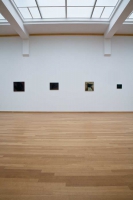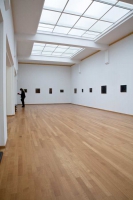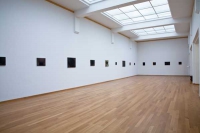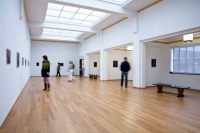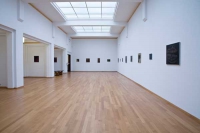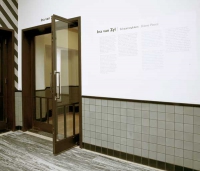Schaamstukken / Shame Pieces
Excerpt from press release:
Ina van Zyl’s exhibition in the Projects Gallery of the Gemeentemuseum takes on the form of an installation entitled Shame Pieces. The paintings in it show realistic close-ups of genitals, both male and female, and occasionally images of other objects, such as a luxuriant red flower, a dark-coloured fruit or a walnut. They are not shocking as such. They are details of the world we live in, blown up to images that at times almost become abstract. The artist’s subtle, playful handling of paint makes her work seem introverted, although anger and aggression are always around.
The heat of South Africa pervades the subjects of her earlier work: varnished toenails in sandals, sweet fruit like apples and plums. These days, the emphasis lies more on the deep, dark, intense colours of South African nature, as found in the vast, empty landscape of the Karoo. At first glance, expectations of political engagement are not met. There is no direct reference to the rainbow nation of the new South Africa or to the previous apartheid era, the tumultuous period of her youth. Even so, here lies her focus. But instead of showing an immediately apparent political reality, she addresses the mechanisms underlying the political legacy of her country: hidden forces like power, oppression and humiliation are her chosen territory.
In Shame Pieces, Van Zyl explores these mechanisms in her own, highly distinctive way. But her work invariably operates on a number of different levels. Shame Pieces is not only about power and sexual violence; it is also about the humiliations that people impose on themselves, for example by following fashions in the removal of body hair. The works in this series are strongly interrelated but, at the same time, each is a world in itself.
The sexual connotations with close-ups of genitals are obvious but Van Zyl manages to evoke the same feelings through her images of fruit. She also plays the game in the opposite direction. For example, a vagina may be viewed from such an angle that it looks like a landscape, or be presented stylised to the extent that it almost resembles an abstract composition. This ambiguity is reflected in the effect of the paintings on the viewer, both attracting the eye and instigating feelings of embarrassment and repulsion.
The exhibition is accompanied by a publication containing the essay How to paint shame? by Ernst van Alphen.
